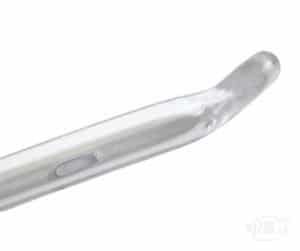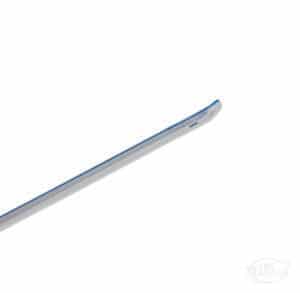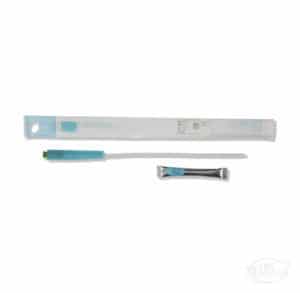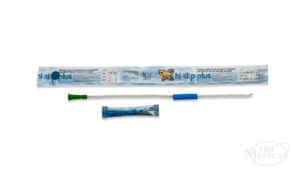
Doctors may prescribe intermittent catheterization to help drain the bladder due to issues like urinary incontinence, bladder retention, incomplete bladder emptying, or neurogenic bladder. While most people find that straight tip catheters suit their needs, not everyone can easily insert straight catheters. This may lead to a need for a curved tip or coudé tip catheter. If you’re one of those people with difficulty inserting straight catheters, you might wonder, “Why do I need to use coudé catheters?”
When you’re new to catheterization, it’s natural to have many questions. Let’s go over some of the answers to frequently asked questions about this catheter type.
What’s the Difference Between Straight and Coudé Catheter Tips?
A urinary catheter is a thin, flexible tube that is inserted into the bladder through the urethral opening or a stoma (typically somewhere on the abdomen or in the navel for a Mitrofanoff). One end typically features a funnel end, which is sometimes color-coded to indicate the catheter’s French size (diameter).
The other end is the tip that gets inserted to drain the bladder. It will feature at least one eyelet or drainage hole for the urine to flow during intermittent catheterization. Urine then travels down the tube and outside the body.

A straight-tip catheter has a straight insertion tip with no curves or bends. These are the most common catheter tips since they tend to work universally for draining the bladder through the urethra or a stoma. However, straight-tip catheters don’t work for everyone’s anatomy.
What is a Coudé Catheter?
Sometimes called a curved tip catheter, a coudé tip catheter (pronounced “coo-day”) has a slight bend or curve at the insertion tip. This angled insertion tip can navigate past difficult urethral passages for many reasons, including false passages, obstructions, strictures in the urethra, and more.
Why Do I Need to Use Coudé Tips?
The short answer is that standard straight tip catheters don’t work for everyone’s anatomy. Most of the time, this issue happens to men who need to use catheters. Here are a few different possible causes:
- Benign Prostatic Hyperplasia (BPH)
- Prior prostate surgery
- Urethral strictures
- False passages in the urethra or a stoma
- Radiation in the pelvic area to treat cancer
- Females with an atrophic vagina
- Those with urinary stricture disease or urethral trauma
Are There Different Types of Coudé Insertion Tips?
Yes! While most coudé catheters feature a gentle tapered curve, others may have a ball-like tip. This is known as an olive tip catheter. Some catheter users may need a more elongated curve like a Tiemann tip catheter.
Here are the three types of coudé catheter insertion tips.

Tapered Tip Catheter
The most common coudé catheter type has a tapered tip. You’ll see a short, strong curve that tapers smaller at the foremost insertion point.
Catheters with a taper tip curve may be ideal for navigating urethral strictures or bypassing enlarged prostates.
Olive Tip Catheter (Ball Tip)
The olive tip catheter features a ball-shaped insertion tip. Olive tip catheters, although a rarer option, may work well for people with false urethral passages, which longer insertion tips may catch on.
Tiemann Catheter
Tiemann tip catheters have an elongated, tapered curve. This type is often more flexible than other coudé tips as well. Due to its longer curve, the Tiemann tip catheter can be ideal for getting through narrow passages and strictures. Plus, it may provide more comfort for some users thanks to its pliability.
What Types of Coudé Catheters Are Available at 180 Medical?
Coudé catheters are manufactured in all catheter materials, including vinyl or PVC, silicone, and red rubber latex, to name a few. Plus, you can find latex-free or DEHP-free catheter options too. 180 Medical offers a vast selection of options from which to choose. Your comfort and convenience are important when determining which catheter to use. That’s why we offer free catheter samples so you can try and find which one works and feels best for you!
You can get a coudé tip in almost every common catheter type as well, from basic uncoated intermittent catheters, pediatric length catheters, hydrophilic catheters, pre-lubricated catheters, and closed system catheter kits.
Uncoated Coudé Catheter
If you’re looking for a no-nonsense coudé catheter option to lubricate yourself, an uncoated catheter may be your best bet.
180 Medical carries one of the widest varieties of catheter supplies available today. You can also choose from options like vinyl catheters, soft silicone catheters, and red rubber catheters.
Hydrophilic Coudé Catheter
Hydrophilic catheters have a specialized coating that reacts with water to completely lubricate the catheter and make it slippery. There is no need for additional lubrication! The lubricated coating will not slough off as you insert it, which makes cathing more comfortable and frictionless.
Closed System Coudé Catheter Kits
Closed system catheters are great options for those in wheelchairs or on the go. Each closed system features a hydrophilic or pre-lubricated catheter housed inside its own self-contained collection bag. Closed system catheters offer you more convenience, discretion, and comfort, as well as the potential benefits of reduced risk of urinary tract infections.
Can I Change My Supply Order from Straight to Coudé Catheters?
If you suspect you need a coudé catheter, the first step is to talk to your urologist or another prescribing healthcare professional.
The decision will ultimately be up to your urologist or qualified healthcare professional. Then, they must update your prescription to include the need for coudé catheters (A4352).
Some insurance plans, such as Medicare, may require additional justification in doctor’s notes.
180 Medical’s insurance experts can take that extra step off your plate by getting any required documentation from your prescribing healthcare provider (HCP).
Will My Insurance Cover Coudé Tip Catheter Supplies?
Most insurance companies will cover coudé catheters if they are medically necessary. That includes Medicare, private insurance plans, and many state Medicaid programs. The type and allowable amount per month will depend upon your insurance policy’s specified coverage.
For example, Medicare covers up to 200 catheters per month with a doctor’s prescription. Coudé catheter coverage requires some supporting documentation offering justification for the need for a coudé tip. That’s enough catheters to sterilely self-cath between 6 and 7 times daily within a 30-day period.
Not sure what your insurance policy’s catheter coverage is? 180 Medical’s specialists will gladly verify your insurance to determine how your policy covers catheters. Plus, we go over any out-of-pocket costs you may have. We also work with your doctor’s office to get any insurance-required documentation.
That’s less for you to worry about as you learn how to use a coudé catheter.
How Do I Use a Coudé Catheter?
Using a coudé catheter can become second nature with a little practice. Here are some basic instructions for how to catheterize.
- Gather your cathing supplies, then wash your hands and the insertion site with warm, soapy water (if possible). If you’re away from home, you can wear gloves and use travel-sized packets of antiseptic wipes, such as BZK wipes or iodine swabs. Wipe the area with a circular motion around the urethral opening to help reduce your risk of infection.
- Take your catheter out of the package and lubricate it with a sterile, water-soluble lubricating jelly. This helps reduce friction and make cathing more comfortable. If using a hydrophilic catheter, you may need to activate the lubricated coating with sterile water (often included in the package). A closed system or pre-lubricated catheter will likely be ready to use.
- While holding your penis in one hand, use your other hand to hold the catheter. Hold your penis at a 45-degree angle away from your stomach.
- Insert the catheter slowly into your urethra. Some catheters feature guide dots or stripes so you know where the curve of your catheter is. This helps you keep the tip at the angle your doctor recommends. If there is any resistance when the catheter reaches your bladder, take a deep breath and gently apply pressure. However, do not force the catheter.
- When urine begins to flow, insert the catheter an inch or farther. Then you can lower your penis to let urine flow into the toilet or urinal.
- Once the flow of urine has stopped, slowly withdraw the catheter to remove it.
- Throw your used catheter supplies away.
Need more detailed information? Check out our helpful step-by-step instructions and catheterization videos at www.howtocath.com.
Where to Get Home-Delivered Catheters
180 Medical’s catheter experts will work hard to find the right supplies for you and your individual needs and preferences.
With your first order, we can also send you full-color instructional brochures and even a DVD that walks you through the catheterization process step by step.
180 Medical proudly carries one of the largest selections of catheter supplies available today from all of the major manufacturers and catheter brands.
Contact us to speak with one of our highly-trained, friendly specialists about your coudé catheter options.












